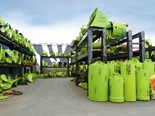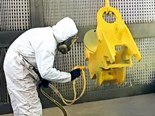Special feature: Working on big rigs across the ditch
We head across the ditch again, this time, to meet Jos Haldane Toy, who is currently working as a High Voltage (HV) electrician at Komatsu in Brisbane
In many cases, your friends and family know your job title but they don’t know what it entails exactly. We began to understand a bit more after a guided tour of the Komatsu factory that’s home to some massive machinery.
 |
|
Jos Haldane Toy next to a brand-new Komatsu D475Adiv
|
Jos has been working at the Komatsu facility for just more than a year, helping on the componentry build of D475A-5EO Super Dozers and D375A-6 Dozer-Crawlers, along with the truck builds of the Komatsu 930E and 830E models, as well as fitting turbo timers and battery isolators, reverse cameras, CD players, and tilt controllers.
After gaining his electrician’s apprenticeship with Trilect Electrical in Auckland and working for a few years around New Zealand’s largest city, Jos, who is 33, decided to try his hand out in Australia. He and his wife Sarah (also a Kiwi) and their baby Zoe, live in Mt Gravatt East and Jos commutes to work at the Komatsu factory in the industrial suburb of Wacol.
This is his second stint at the Wacol site. He was first there in 2011, after attaining his High Voltage switching ticket when he worked at a gold mine in Wiluna in Western Australia (WA).
Working in Western Australia
Jos has worked in some pretty remote places all over Western Australia, first at Norseman, east of Perth; then Wiluna, 950km northeast of Perth; at Christmas Creek, 1500km north of Perth; and Karratha—both in the Pilbara region.
"My first job was testing and tagging at Norilsk Nickel mine near Norseman," Jos says. "This involved doing routine checks of all electrical equipment used in the mine. It’s done every three months and is the same regulations as they have in New Zealand. I was there for about three months before the nickel price bottomed out and lots of mines in the area closed, so I moved on."
Next up was a different challenge: working for Apex Minerals, a gold mine in Wiluna, on ‘swings’ as they’re called, for three weeks on and one off.
 |
|
Flying over Christmas Creek village |
"I did two swings working in electrical construction and one of the guys asked if anyone wanted to do fixed plant maintenance in the concentrator, so I put up my hand. We did swings of eight days on and six days off and did everything from lighting to fitting power outlets, running the cable into control rooms and changing out sensors. After this, I was asked if I wanted to go underground."
Working underground meant setting up extra services to extend the mining operation and was a great learning curve. From the portal to the lowest part of the mine was one kilometre or around 30 minutes’ drive by utes.
"Working with steel wire armour cables on long runs was very physical. The jumbos (see glossary) that drill the face are all underground and run on 1000 volts, so every time a jumbo moves closer into a mine site, you have to move the jumbo box (power supply) in with it.
.jpg) |
|
Home away from home at Eramarra Village for Citic Pacific Mining, Karratha, WA
|
"Jumbos drill huge holes in the rock face and then it is blasted with explosives. A bogger—or underground loader—then comes in to move the dirt out. We were also in charge of setting up all the pump boxes to pump excess water out to the surface, as so much water is used in the drilling process."
During the 18 months he was there, Jos says he saw a gold haul—you get checked each time you leave the mine, in case you’re wondering, but here’s a funny story: "They used to send a guy in to pick up the gold bullion. He travelled on a small plane without any extra security, and he took the gold bar away in an ordinary old lunch box."
Interestingly, some of the people Jos worked with had been working underground for 20–30 years. After that, Jos and Sarah decided to move back east to Brisbane, as it was closer to family in New Zealand. The first stint at Komatsu followed, doing HV work on the trucks.
A copper mine in Cloncurry, 770km northwest of Townsville was his next stop. One of his jobs there was to set up remote control operations for a 60-tonne Atlas Copco bogger, (underground wheeled loader). At Karratha, Jos spent two years working at Citic Pacific Mining on Terex Ultra class trucks.
.jpg) |
|
A Brockman2 DC truck rebuild in progress at a mine in WA |
"With 400-tonne payloads, they are the biggest trucks in the world," Jos says. "They had 24 6300s (MT6300AC), four 3300 water carts, four service trucks and 10 4400s, all Terex. All up, there were 30–40 trucks operating 24/7."
Campsites vary, he says. While most are good, even if they are basic, the Cloncurry one was the worst, he says—a 2x2m room with a 20-metre walk to showers and toilets. On the upside, most sites have lots of after work activities on offer such as touch rugby, tennis, indoor squash, a gym, and swimming pool. And to keep things going, there are also a few traditions at campsites such as fish and chip Fridays and roast on Sundays. Usually, there’s also a pub in the area.
"One camp had three different campsites, all within walking distance and three pubs, so one night we decided to do a pub crawl and went to each just to see what they were like," Jos says.
Enduring tough conditions
.jpg) |
|
Brand-new machinery ready for dispatch
|
The desert can be a tough environment to work in. Jos recalls temperatures at Christmas Creek (where he worked for Macmahon Holdings in 2015), hitting 75 degrees on the concrete tyre pad.
"It’s hot and dusty and there’s always lots of flies," he says. "In the wet season, there’s the threat of hurricanes as well, and when that happens, a site goes into lockdown. We had to leave at midnight on one occasion because the water level rose so high.
.jpg) |
|
Work in progress on the factory floor at Wacol
|
"Our supervisor made a call to get everyone out so we jumped on the bus and got off the site with our ration packs. In the previous year, they got flooded out and the workers had to jump on the side of a grader to get back to camp."
A sense of camaraderie
 |
|
PC 300 excavator |
Jos says the best thing on the mining sites is the people you work with.
"There’s a huge mix of personalities from Papua New Guinea, Zimbabwe, Philippines, South Africa, and lots of Kiwis, English, and Irish. There’s a lot of older workers and lots with families.
" I’ve made some very good friends over the years; they definitely make a place and compensate for the downside of being away from home and the amount of travel involved.
"To give you some idea, for each swing I had to fly five hours from Brisbane to Perth, stay overnight at the airport, then fly two hours from Perth to Karratha, then a further hour on the bus." That’s a long commute to work.
.jpg) |
|
PC228USLC is a powerful excavator for confined spaces or urban areas
|
Overall, Jos has enjoyed taking on each challenge as it comes up. "You don’t grow if you’re not challenged," is his take on it. Now he’s about to take on another one. He’s shortly due to leave Komatsu to do another fly in/fly out job in North Queensland at HSE Mining in Mackay, where he’ll be working on Komatsu 830E -1AC dump trucks.
His long-term goal is to get into solar power but for now, the large trucks are keeping him busy.
Glossary: Mining terms
Jumbo: A drilling jumbo consists of one, two, or three rock drill carriages, sometimes a platform, which the miner stands on to load the holes with explosives.
Concentrator: A milling plant that produces a concentrate of the valuable minerals or metals. Further treatment is required to recover the pure metal.
Keep up to date in the industry by signing up to Deals on Wheels' free newsletter or liking us on Facebook.







